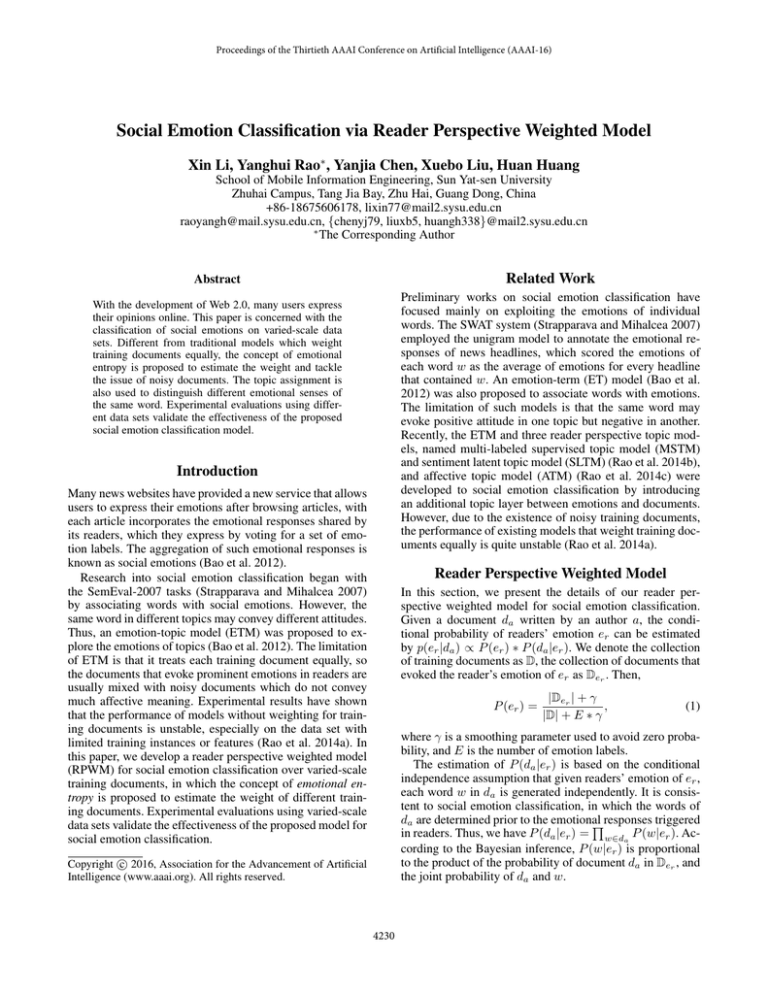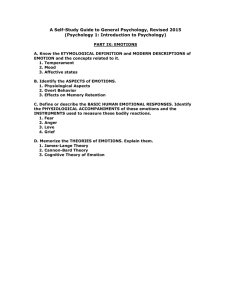
Proceedings of the Thirtieth AAAI Conference on Artificial Intelligence (AAAI-16)
Social Emotion Classification via Reader Perspective Weighted Model
Xin Li, Yanghui Rao∗ , Yanjia Chen, Xuebo Liu, Huan Huang
School of Mobile Information Engineering, Sun Yat-sen University
Zhuhai Campus, Tang Jia Bay, Zhu Hai, Guang Dong, China
+86-18675606178, lixin77@mail2.sysu.edu.cn
raoyangh@mail.sysu.edu.cn, {chenyj79, liuxb5, huangh338}@mail2.sysu.edu.cn
∗
The Corresponding Author
Related Work
Abstract
Preliminary works on social emotion classification have
focused mainly on exploiting the emotions of individual
words. The SWAT system (Strapparava and Mihalcea 2007)
employed the unigram model to annotate the emotional responses of news headlines, which scored the emotions of
each word w as the average of emotions for every headline
that contained w. An emotion-term (ET) model (Bao et al.
2012) was also proposed to associate words with emotions.
The limitation of such models is that the same word may
evoke positive attitude in one topic but negative in another.
Recently, the ETM and three reader perspective topic models, named multi-labeled supervised topic model (MSTM)
and sentiment latent topic model (SLTM) (Rao et al. 2014b),
and affective topic model (ATM) (Rao et al. 2014c) were
developed to social emotion classification by introducing
an additional topic layer between emotions and documents.
However, due to the existence of noisy training documents,
the performance of existing models that weight training documents equally is quite unstable (Rao et al. 2014a).
With the development of Web 2.0, many users express
their opinions online. This paper is concerned with the
classification of social emotions on varied-scale data
sets. Different from traditional models which weight
training documents equally, the concept of emotional
entropy is proposed to estimate the weight and tackle
the issue of noisy documents. The topic assignment is
also used to distinguish different emotional senses of
the same word. Experimental evaluations using different data sets validate the effectiveness of the proposed
social emotion classification model.
Introduction
Many news websites have provided a new service that allows
users to express their emotions after browsing articles, with
each article incorporates the emotional responses shared by
its readers, which they express by voting for a set of emotion labels. The aggregation of such emotional responses is
known as social emotions (Bao et al. 2012).
Research into social emotion classification began with
the SemEval-2007 tasks (Strapparava and Mihalcea 2007)
by associating words with social emotions. However, the
same word in different topics may convey different attitudes.
Thus, an emotion-topic model (ETM) was proposed to explore the emotions of topics (Bao et al. 2012). The limitation
of ETM is that it treats each training document equally, so
the documents that evoke prominent emotions in readers are
usually mixed with noisy documents which do not convey
much affective meaning. Experimental results have shown
that the performance of models without weighting for training documents is unstable, especially on the data set with
limited training instances or features (Rao et al. 2014a). In
this paper, we develop a reader perspective weighted model
(RPWM) for social emotion classification over varied-scale
training documents, in which the concept of emotional entropy is proposed to estimate the weight of different training documents. Experimental evaluations using varied-scale
data sets validate the effectiveness of the proposed model for
social emotion classification.
Reader Perspective Weighted Model
In this section, we present the details of our reader perspective weighted model for social emotion classification.
Given a document da written by an author a, the conditional probability of readers’ emotion er can be estimated
by p(er |da ) ∝ P (er ) ∗ P (da |er ). We denote the collection
of training documents as D, the collection of documents that
evoked the reader’s emotion of er as Der . Then,
P (er ) =
|Der | + γ
,
|D| + E ∗ γ
(1)
where γ is a smoothing parameter used to avoid zero probability, and E is the number of emotion labels.
The estimation of P (da |er ) is based on the conditional
independence assumption that given readers’ emotion of er ,
each word w in da is generated independently. It is consistent to social emotion classification, in which the words of
da are determined prior to the emotional
responses triggered
in readers. Thus, we have P (da |er ) = w∈da P (w|er ). According to the Bayesian inference, P (w|er ) is proportional
to the product of the probability of document da in Der , and
the joint probability of da and w.
c 2016, Association for the Advancement of Artificial
Copyright Intelligence (www.aaai.org). All rights reserved.
4230
The probability of da in Der measures the weight of
each document under the same emotional category. Different from a typically single emotion expressed by an author, a
distribution of reader attitudes can be present across the span
of a document (Lin and Chen 2008). For example, two documents d1 and d2 may have the following number of reader
ratings over four emotions: {0, 0, 0, 5} and {1, 1, 1, 2} (E =
4). Although both d1 and d2 have the highest ratings for the
last emotion, their importance is different for that emotion.
In our work, the concept of emotional entropy is proposed to
estimate the weight of document da in Der , as follows:
P (da ) =
E
(P (eir |da ) ∗ logE (P (eir |da ))) + 1,
for training, and the 2228 documents published from March
to April, 2012 were used for testing.
We implemented the following models for comparison:
SWAT (Strapparava and Mihalcea 2007), ET and ETM (Bao
et al. 2012), MSTM and SLTM (Rao et al. 2014b), and ATM
(Rao et al. 2014c). All parameters were set empirically. Table 1 present the micro-averaged F1 measure of different
models, from which we can observe that RPWM outperformed baselines on both data sets, especially for SemEval
that contains limited training instances or features.
Models
SWAT
ET
ETM
MSTM
SLTM
ATM
RPWM
(2)
i=1
where the first item in the right side of the formula is the
negative value of the emotional entropy of da , the values
of which range from -1 to 0, with the lowest being readers voted for each emotion equally and the highest being all
readers voted for a single emotion. The second item of 1 is
used to constrain the value of P (da ) between 0 and 1.
The joint probability of document da and word w can be
estimated by the occurrence of words in documents simply. However, due to words may have emotional ambiguity, the topic assignment is used as a “bridge” to associate
documents with words accurately. We denote the multinomial distribution of document da over topics as θda , and the
multinomial distribution of word w over topics as ξw . Then,
the cosine-similarity is employed to calculate the joint probability of da and w as follows:
P (da , w) =
θda ∗ ξ w
.
|θda | ∗ |ξw |
(z)
nda + α
(z)
where
(z)
nda
(z )
Σz (nda + α)
(z)
=
, ξw
Conclusion
Social emotion classification is useful to provide users with
more relevant and personalized services. In this paper, we
have proposed the emotional entropy to alleviate the issue of
noisy training documents, and used the topic assignment to
distinguish different emotional senses of the same word. For
future work, we plan to improve the emotional entropy by
developing a generalized index of document importance.
(3)
Acknowledgments
This research was supported by the Natural Science Foundation of China (no. 61502545) and the Fundamental Research
Funds for the Central Universities (no. 46000-31610009).
(z)
nw + α
(z )
Σz (nw
+ α)
,
SinaN ews
50.63%
42.91%
52.90%
49.83%
49.50%
49.58%
56.12%
Table 1: The micro-averaged F1 of different models.
The above multinomial distributions (i.e., θda and ξw ) can
be estimated by Gibbs sampling, as follows:
θd a =
Semeval
31.40%
31.00%
24.65%
20.80%
20.85%
32.45%
36.47%
(4)
References
Bao, S.; Xu, S.; Zhang, L.; Yan, R.; Su, Z.; Han, D.; and Yu,
Y. 2012. Mining social emotions from affective text. IEEE
Trans. Knowl. Data Eng. 24(9):1658–1670.
Lin, K. H.-Y., and Chen, H.-H. 2008. Ranking reader emotions using pairwise loss minimization and emotional distribution regression. In Proc. Empirical Methods in Natural
Language Processing, 136–144.
Rao, Y.; Lei, J.; Wenyin, L.; Li, Q.; and Chen, M. 2014a.
Building emotional dictionary for sentiment analysis of online news. World Wide Web 17(4):723–742.
Rao, Y.; Li, Q.; Mao, X.; and Wenyin, L. 2014b. Sentiment topic models for social emotion mining. Information
Sciences 266:90–100.
Rao, Y.; Li, Q.; Wenyin, L.; Wu, Q.; and Quan, X. 2014c.
Affective topic model for social emotion detection. Neural
Networks 58:29–37.
Strapparava, C., and Mihalcea, R. 2007. Semeval-2007 task
14: Affective text. In Proc. 4th International Workshop on
Semantic Evaluations, ACL, 70–74.
is the number of words in document da assigned
(z)
nw
to topic z,
is the number of instances of word w assigned to topic z, and the consistent smoothing parameter α
is specified by users empirically.
Experiments
In this section, we detail the data sets, experimental design and results. To evaluate the effectiveness and adaptiveness on the proposed model, two data sets were employed: SemEval (Strapparava and Mihalcea 2007) and
SinaN ews (Rao et al. 2014c). The first data set contained
1250 real-world news headlines, and each headline was
manually scored across 6 emotions. After pruning 4 items
with the total scores equal to 0, we used the 246 headlines
in the development set for training and the rest for testing.
The second data set consisted of 4570 documents from Sina
news, and reader ratings over 8 emotions. Due to that adjacent documents may have similar contexts, the 2342 documents published from January to February, 2012 were used
4231








